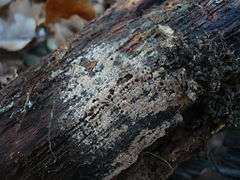Tomentella
Tomentella is a genus of corticioid fungi in the family Thelephoraceae. The genus is ectomycorrhizal, and widespread, with about 80 species according to a 2008 estimate, although many new species have since been described.[2] Tomentella was circumscribed by French mycologist Narcisse Théophile Patouillard in 1887.[3]
Tomentella spores 1000x
| Tomentella | |
|---|---|
 | |
| Tomentella radiosa, Austria | |
| Scientific classification | |
| Kingdom: | |
| Division: | |
| Class: | |
| Order: | |
| Family: | |
| Genus: | Tomentella Pers. ex Pat. (1887) |
| Type species | |
| Tomentella ferruginea (Pers.) Pat. (1887) | |
| Synonyms[1] | |
| |
Species
- T. africana – Benin (West Africa)[4]
- T. afrostuposa
- T. agbassaensis
- T. agereri[5]
- Tomentella alpina[6]
- T. angulospora
- T. asperula
- T. atroarenicolor
- T. atrovirens
- T. aurantiaca
- T. badia
- T. beaverae – Seychelles[7]
- T. brevispina
- T. brunneorufa
- T. bryophila
- T. calcicola
- T. carbonaria
- T. cinerascens
- T. cinereoumbrina
- T. clavigera
- T. coerulea
- T. crinalis
- T. donkii
- T. duemmeri
- T. ellisii
- T. epigaea
- T. ferruginea
- T. ferruginella
- T. fibrosa
- T. fragilis
- T. fraseri
- T. fungicola
- T. furcata
- T. fuscocinerea
- T. fuscoferruginosa
- T. galzinii
- T. gigaspora
- T. griseoumbrina
- T. griseoviolacea – Canada[8]
- T. guadalupensis
- T. himalayana – Himalayas[9]
- T. hjortstamiana – Seychelles[7]
- T. indica – Himalayas[9]
- T. intsiae – Seychelles[7]
- T. italica
- T. juncicola – Benin[10]
- T. kentuckiensis
- T. kootenaiensis
- T. lapida
- T. larssoniana – Seychelles[7]
- T. lateritia
- T. lilacinogrisea[8]
- T. maroana[5]
- T. microspora
- T. molybdaea
- T. muricata
- T. nitellina
- T. oligofibula – Canary Islands[11]
- T. olivascens
- T. parmastoana – Seychelles[7]
- T. pellicularioides – Trinidad[8]
- T. phylacteris
- T. pilatii
- T. pileocystidiata – Seychelles[7]
- T. pilosa
- T. pisoniae – Seychelles[7]
- T. puberula
- T. punicea
- T. pyrolae
- T. radiosa
- T. retiruga – Réunion[12]
- T. scobinella
- T. spinosispora
- T. stuposa
- T. subalpina
- T. subamyloidea – Western Australia[13]
- T. subcinerascens
- T. subclavigera
- T. subcorticioides – Himalayas[9]
- T. sublilacina
- T. subtestacea
- T. subvinosa
- T. tedersooi – Seychelles[7]
- T. tenuis – Seychelles[7]
- T. terrestris
- T. testaceogilva
- T. umbrinospora
- T. variecolor
- T. vesiculosa
- T. viridescens
- T. viridula
gollark: Three if you count mine.
gollark: Chorus City now has *two* houses! That's two more than zero!
gollark: Ah.
gollark: No, but I mean, first it says "Success!" then gives an error.
gollark: It should probably not say "success" until it's actually linked without an error.
References
- "Tomentella Pers. ex Pat. 1874". MycoBank. International Mycological Association. Retrieved 2011-11-15.
- Kirk PM, Cannon PF, Minter DW, Stalpers JA (2008). Dictionary of the Fungi (10th ed.). Wallingford, UK: CAB International. p. 693. ISBN 978-0-85199-826-8.
- Patouillard N. (1887). Les Hyménomycètes d'Europe (in French). p. 154.
- Yorou NS, Agerer R (2008). "Tomentella africana, a new species from Benin (West Africa) identified by morphological and molecular data". Mycologia. 100 (1): 68–80. doi:10.3852/mycologia.100.1.68. PMID 18488353.

- Yorou NS, Guelly AK, Agerer R (2011). "Anatomical and ITS rDNA-based phylogenetic identification of two new West African resupinate thelephoroid species". Mycoscience. 52 (6): 363–75. doi:10.1007/s10267-011-0117-4.
- Peintner U, Dämmrich F (2012). "Tomentella alpina, an important mycobiont of alpine ectotrophic plants". Mycological Progress. 11 (1): 109–19. doi:10.1007/s11557-010-0734-x.
- Suvi T, Tedersoo L, Abarenkov K, Beaver K, Gerlach J, Kõljalg U (2010). "Mycorrhizal symbionts of Pisonia grandis and P. sechellarum in Seychelles: identification of mycorrhizal fungi and description of new Tomentella species". Mycologia. 102 (3): 522–33. doi:10.3852/09-147. PMID 20524585.
- Wakefield EM. (1966). "Some extra-European species of Tomentella". Transactions of the British Mycological Society. 49 (3): 357–62. doi:10.1016/s0007-1536(66)80077-3.
- Rattan SS. (1977). The resupinate Aphyllophorales of the North Western Himalayas. Bibliotheca Mycologica. 60. J. Cramer. ISBN 978-3768211727.
- Yorou NS, Agerer R (2007). "Tomentella furcata, a new species from Benin (West Africa) with basidia forming internal hyphae". Mycological Progress. 6 (4): 239–47. doi:10.1007/s11557-007-0543-z.
- Larsen MJ, Beltrán-Tejera E, Rodríguez-Armas JL (1994). "Tomentella oligofibula sp.nov. (Aphyllophorales, Thelephoraceae s. str.), from the Canary Islands". Mycotaxon. 52 (1): 109–12.
- Martini EC, Hentic R (2002). "Deux nouvelles espèces de champignons tomentelloides". Bulletin de la Société Mycologique de France. 118 (2): 79–90.
- Agerer R, Bougher NL (2001). "Tomentella subamyloidea sp nov and T. radiosa (Thelephoraceae, Hymenomycetes, Basidiomycota) from Australia". Australian Systematic Botany. 14 (4): 607–14. doi:10.1071/SB00031.
This article is issued from Wikipedia. The text is licensed under Creative Commons - Attribution - Sharealike. Additional terms may apply for the media files.